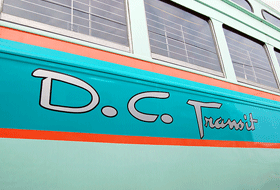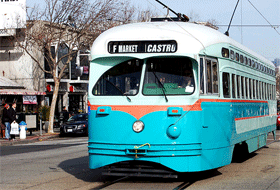This car’s exterior commemorates Washington DC, which operated PCC streetcars from 1937 to 1962.
 Todd Lappin photo.
Todd Lappin photo.One early complaint about streetcars was the visual impact of overhead wires.
In 1893, Congress banned such wires in downtown Washington DC (about the time San Francisco did the same on Market Street). But in Washington the ban stuck, requiring a different technology to power streetcars.
Washington put the wire in a conduit between the rails, making their tracks look just like cable car tracks. Traditional trolley poles were used on the outer ends of the line, switching to ‘plows’ where the wires ended.
 Todd Lappin photo.
Todd Lappin photo.When Washington purchased its 489 streamlined PCCs beginning in 1937, they had this dual-power technology. The federal government, which regulated the private operator, Capital Transit, provided an incentive by ruling that unlike its older streetcars, Washington’s PCCs could be run with a single operator.
Capital Transit’s PCC livery was a rather restrained blue-green and gray. But that changed as part of a big shakeup. Antagonized by the new hard-line owner of Capital Transit, the federal government revoked its franchise and awarded it in 1956 to an entrepreneur named O. Roy Chalk, on the condition that the streetcars would be replaced with buses by 1963. Chalk fought for the PCCs, experimentally air-conditioning one and proposing innovative services.
Chalk renamed the system D.C. Transit and tucked it into his business empire as a subsidiary of Trans Caribbean Airways. He painted up his transit vehicles in a tropical theme, and even installed Trans Caribbean Airways counters in DC Transit ticket offices; rather like offering Jet Blue tickets at Muni Metro stations.
Despite Chalk’s efforts, DC Transit foundered financially and was taken over by the government, like virtually ever other transit system, with streetcars disappearing from Washington in 1962. But the livery lives on with car No. 1076, right down to the decal by the front door saying, “An Affiliate of Trans Caribbean Airways.”
» Capital Addition to the Active F-Line Fleet
 Originally built for
Originally built forTwin City Rapid Transit Co., Minneapolis-St. Paul, MN, 1946 (as car No. 331)
Sold to
Public Service Coordinated Transport, Newark, NJ, 1953 (as car No. 12)
Acquired by Muni from
New Jersey Transit, Newark, NJ, 2004
Builder
St. Louis Car Co.
Restored by
Brookville Equipment Company, PA, 2004-2011
Seats
50
Weight
37,600 lbs.
Length
46′ 5″
Width
9′ 0″
Height
10′ 3″
Motors
4 General Electric 1220
Trucks
B-2
Brakes
Electric
